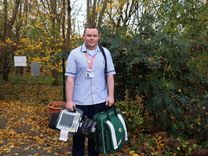Paramedics and hospice join forces to support end-of-life patients at home
Date: 15 January 2024East of England Ambulance Service NHS Trust (EEAST) is leading the way in joining up the skills of emergency and end-of-life care professionals in the community by embedding its paramedics in an Essex hospice in a scheme that thought to be one of the first of its kind in England.

Three paramedics are working in rotation between the ambulance service and St Helena Hospice’s SinglePoint – a 24/7 helpline and rapid response service for people receiving end-of-life care and support at home across north-east Essex.
The split role offers a unique opportunity for collaborative working, while sharing skills and knowledge between the organisations, and focuses on helping end-of-life patients get the help they need, while respecting their wishes to be cared for at home.
Nicky Coombes, Hospice in the Home Matron at St Helena, said: “For our patients, it's about keeping them in the place where they want to be cared for and giving them support so they can remain at home and are less likely to be conveyed to hospital.
“Having the paramedics on the team has added value to our SinglePoint service.
“Their skill sets are different so they can go out and do their assessment and diagnostics, and if a patient has fallen, they can often do wound care there and then.
“We're now getting more calls from paramedics out on the road generally because the paramedics working with us are telling their colleagues about what we can do at St Helena, whereas their first thought previously would have been to take the patient directly to hospital.
“The paramedics feel more comfortable having conversations about advance care planning and recognising what’s needed for patients in the dying process."
Rachel Hunt, End of Life Care lead for EEAST, said: “Having our clinicians embedded within St Helena Hospice’s SinglePoint system means the nursing team can benefit from our staff’s training in making swift assessment. This allows them to assess and deal with many patient’s non-urgent issues – often without the need to call an ambulance or transport them to hospital.
“This ensures people can get the care they need, while staying in their own home for as long as possible.”
For the ambulance clinicians, dealing with end-of-life patients and supporting their families are another set of skills they can use to develop professionally.
They can also take a further training module in end-of-life care that EEAST has developed with the University of East Anglia.
Scott O'Rourke, one of the EEAST paramedics on rotation with St Helena Hospice, explains how it works in practical terms: “During the day shifts on my roster, I come into the hospice and I'm based out of SinglePoint, doing patient assessments and assistance and trying to help keep people at home. And then during my night shifts, I work for the ambulance service on either a rapid response car or on an emergency ambulance as a paramedic going to a wide range of calls. This allows me to keep up all of my chronic and acute assessment and treatment skills.
“It produces a really nice merger of roles because it means I'm constantly able to keep updated with new treatments and medication and management of conditions, and I can bring that learning into the Hospice for patients to be treated at home. And likewise if, as a paramedic, I go to someone who's deteriorating quite rapidly or may present as being end-of-life in the community, I can bring the knowledge learned from St Helena Hospice.
“The biggest benefit I've learned being at St Helena Hospice is the communication aspects of speaking to patients and family about the advance care planning side of things.
“The biggest skill or knowledge I’ve brought into the Hospice as a paramedic is the acute assessment skills; they have proved to be really beneficial to help identify whether something is actually treatable at home.”
